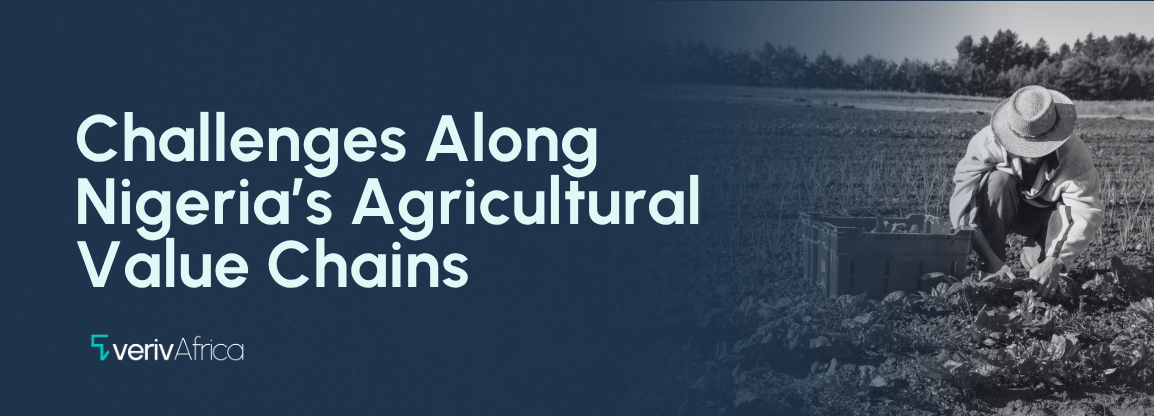Agriculture employs nearly 50% of the labour force in African economies and contributes up to 35% of the continent’s Gross Domestic Product. In Nigeria, smallholder farmers comprise over 80% of the total farming population. However, they face several key challenges that continue to hamper optimal productivity. This article, the first in a new series on agricultural market opportunities in Nigeria and Africa, outlines key challenges facing the Nigerian agriculture sector, proposes strategies to address them, and offers practical guidance for stakeholders—including corporations, governments, and investors—to harness these opportunities.
The Agricultural Sector: A Snapshot
The Nigerian agricultural sector remains one of the largest employers of labour in the country. In addition to providing jobs, it supports the livelihoods of rural dwellers by providing income and food. It also provides a tax base, albeit at suboptimal levels, for local and state governments in food-producing regions.
The agriculture sector is largely dominated by smallholder farmers, who comprise nearly 88% of Nigeria's total farming population and account for a substantial percentage of the country's food and cash crop production. The rest of the farming population comprises small, medium, and a few large-scale producers often active in select value chains, such as poultry, oil palm, cocoa, etc.
While Nigeria’s farming population is substantial, as highlighted above, a significant gap exists between the demand and supply of key food products, necessitating nearly 1 trillion naira in food imports per quarter. Wheat, milk, frozen poultry, and sugar are the top imports. Nigeria’s inability to meet local demand for food and continued underperformance in key agriculture export markets stems from several challenges related to poor policies, chronic underinvestment, and outdated agricultural methods, among others.
Key Challenges Affecting the Agriculture Sector
The agriculture sector, like other key sectors of the Nigerian economy, faces multiple challenges. These factors impact local food production, with consequences for food security and political stability. Beyond this, the continued underperformance of the sector bodes terribly for fiscal growth, inflation control, and economic diversification. Some of these challenges include:
- Financing: Lack of well-priced financing remains a key limiting factor to the Nigerian agricultural sector. Smallholder farmers, many of whom lack the requisite documents, including proofs of identity, residence, and land ownership, are often denied financing by financial institutions and government-financed initiatives due to their inability to meet these requirements. When they can secure financing from non-traditional sources such as loan sharks and, more recently, loan apps, the high cost of financing, which can go up to 300% per year, automatically exposes these farmers to high default risk before the crops are harvested. While many of these farmers have owned the land they work on for years, some passed on through generations, the communal or familial nature of the land, and the lack of official documentation, prevent the use of this land as collateral for loans from government-financed programs or nearby microfinance banks.
- Climate-induced Insecurity: Repeated clashes between farmers and herders in key food-producing states have impacted lives and productivity. Between 2001 and 2018, an estimated 60,000 people were killed and another 300,000 displaced due to clashes between farmers and herders. While opinions differ over the remote causes of these clashes, there is no doubt that the changing climate and increasing desertification of other parts of the country have played a role in the economic migration by cattle herders, into farmer-dominated states in the country. These clashes have in turn worsened insecurity in farmer communities, with attendant consequences on food production, food inflation, and income levels in many states.
Beyond the security implication of worsening climate conditions, there are concerns over the impact of the changing climate on farmer income levels, and the larger economy. In 2022, Nigeria lost nearly $7 billion in damaged properties and farmlands to flooding and continues to lose an estimated 300,000 hectares of land annually to desertification. If these statistics continue to be replicated or worsen in the coming years, Nigeria’s ability to meet her local food demand and harness opportunities in the export markets could be severely affected.
- Farmer Productivity: The productivity of Nigerian farmers, especially in the face of worsening climate and environmental conditions, continues to be suboptimal. Farmers continue to rely heavily on family labour, subsistence farming, and outdated/unsustainable farming methods. These conditions are compounded by a lack of access to timely agricultural extension services, storage infrastructure, and other complementary services and facilities to help improve farmer productivity. Locally, these shortcomings continue to impact yield statistics as farmers struggle to meet Africa’s and the global average for yield per hectare for food and cash crops. Data from the Food and Agricultural Organization show that Nigeria records one of the lowest yields per hectare among its peer countries in key crop groups. Beyond the impact on local food production and food security, these yield figures could affect farmers' ability to compete in key export markets for cash crops.
Turning Challenges into Opportunities
The preceding section highlighted key structural challenges bedevilling the agriculture sector. Nonetheless, the sector holds great potential for investors, host governments, and value chain stakeholders. In H1 of 2024, the non-oil sector, largely dominated by key cash crops, recorded increased growth to over $2.7 billion in export receipts. Cocoa and sesame each earned at least $200 million. With over 70 million hectares of arable land, of which only 36 million hectares are currently cultivated, and a youthful population to match, there are enormous potentials, if the aforementioned challenges are tackled. A few strategies are highlighted below:
Financing: Lack of financing remains a major limiting factor. In the medium term, there is a need for state governments, who are the constitutional custodians of land in Nigeria, to tackle the problem of low land documentation, especially in the food-producing areas of the country. The rise in drone mapping technology has decreased the cost of assigning names to parcels of land and providing requisite government-backed documents at scale. If this is tackled alongside increased registration for the National Identity Number (NIN) and ease of access to proofs of residence, millions of farmers would be able to meet the minimum requirements for accessing credit from microfinance banks and other local financial institutions and government-backed initiatives. A successful completion of this exercise will unleash at least $300 billion in dead capital related to informally held real estate, including agricultural land, in Nigeria. That is a good place to start.
Beyond unleashing Nigeria’s dead capital, other financing sources, especially contract financing, must be harnessed and encouraged. An example is contract farming. Under this scheme, the buyer, usually a food processing or commodities trading company, provides input, insurance, limited capital, and extension services upfront in exchange for certainty of delivery after harvest at a set price. If structured properly, the farmer gains the bulk of what he/she would usually purchase with a pre-harvest loan without the hassle of the loan application. On the other hand, the buyer is assured of ample supply at pre-agreed quality levels and prices, thereby addressing supply uncertainties. While this style of financing has been deployed sparingly for cash crop cultivation, it could be standardised and deployed at scale for both food and cash crops. By converting buyers into financiers, the sector could see significant improvement in productivity while tackling the limitations of farmer-funded production.
The Climate and Insecurity: Key stakeholders in the sector, including local/state governments, community leaders, farmer and herder leaders, security agencies, and civil society organizations must work jointly to tackle the menace of farmer-herder clashes, which continue to pose a significant risk to Nigeria’s ability to meet basic demand for food. However, beyond tackling the security consequences of climate change, there is the need to design and deploy practical strategies aimed at helping farmer communities adapt to the changing climate and its impact on the soil. Practices such as agroforestry, regenerative agriculture, reforestation, and other methods that hold the potential for developing resilience must be taught, and funded by governments, corporations, and nonprofits. By educating farmers and empowering them to adopt pro-climate practices, especially in the most affected states, Nigeria can stem the scourge of soil degradation, deforestation, and other changes that fuel crises and impact productivity.
Farmer Productivity: To help farmers and their families adopt the latest agricultural methods, information must be disseminated through diverse channels targeting farmers, community leaders, and key decision-makers in the agriculture sector. To disseminate information effectively, governments—especially at the state and local levels—must collaborate with development partners and corporations to provide essential storage, processing facilities, and other infrastructure. These efforts will enable farmers to boost productivity and safely store their produce until favourable market conditions emerge. The rise in storage facilities as a service, including cold chain facilities in rural areas by ColdHubs, is a welcome development in the sector. The model could be replicated for other scarce storage and processing facilities.
Nigeria’s vast arable lands, youthful population, and increasing expansion into key global crop value chains present an opportunity for corporations and investors to enter the market, ensure supply certainty, and harness the profit potential. Similarly, they present opportunities for host local and state governments to expand their revenue base, improve food security, and contribute to the larger national economy. However, each stakeholder must play its part.
At Veriv Africa, we work closely with all stakeholders to turn challenges and limitations into scalable opportunities. A key part of this strategy is the Veriv Africa food production dashboard which is in the works and will provide real-time data on pricing, production, and the state of play in key food and cash crop value chains.
Stay tuned!
References
Food and Agriculture Organization. (2015). Small family farms country factsheet. Retrieved from https://openknowledge.fao.org/server/api/core/bitstreams/8ce31a78-2848-4388-87a9-a3b1abb73e40/content
Nigerian Export Promotion Council. (2024, September 2). Nigeria rakes in $2.4 billion from non-oil exports in the first half of 2024. Retrieved from https://nepc.gov.ng/blog/2024/09/02/diversification-nigeria-rakes-in-2-7bn-from-non-oil-exports-in-the-first-half-of-2024/
United Nations Office for Outer Space Affairs. (2022). Desert encroachment monitoring in north-eastern Nigeria. Retrieved from https://www.unoosa.org/documents/pdf/psa/activities/2022/UN-Austria/Mahmoud_Ibrahim_Mahmoud.pdf
World Economic Forum. (2023, March). How Africa’s AfCFTA will boost its agriculture. Retrieved from https://www.weforum.org/stories/2023/03/how-africa-s-free-trade-area-will-turbocharge-the-continent-s-agriculture-industry/










